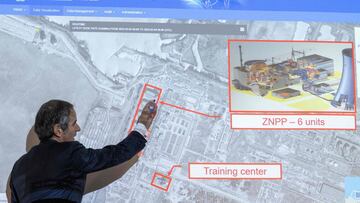Where are Europe's nuclear power plants? Map of power plants around the world
The Russian invasion of Ukraine has put the invaders in control of some of Europe's largest nuclear facilities, where are the others on the continent?


The Russian capture of Europe's largest nuclear power plant in Zaporizhzhia, southern Ukraine, has drawn widespread condemnation after fighting was reported in close proximity to the nuclear reactor.
#Ukraine regulator tells IAEA there has been no change reported in #radiation levels at the #Zaporizhzhia Nuclear Power Plant site.
— IAEA - International Atomic Energy Agency (@iaeaorg) March 4, 2022
It has also highlighted Ukraine's reliance on nuclear power, over 51 percent of all power in the country is nuclear, in a time where many countries were considering winding down production. The war in Ukraine and subsequent energy crisis has focused minds on how best to keep the lights on; there could be a way back for nuclear power prominence.
Related stories:
- Could the Zaporizhzhia nuclear power plant fire be worse than the Chernobyl explosion?
- What is the NATO Response Force?
- What is the correct way to spell the name of Ukraine's president?
- Why do we need nuclear power plants?
Where are the European nuclear reactors?
In total, the world is home to 435 operable nuclear reactors, with 103 stations in 13 European Union (EU) states. Six non-EU nations use nuclear power: Armenia, Belarus, Russia, Switzerland, Ukraine, and the United Kingdom.
In Europe, France leads the way with 56 plants, followed by Russia with 37. Ukraine has the third most facilities with 15, although some have been occupied by the advancing Russian forces.
The actual nuclear specialists are coming out of the woodwork to say that no, it would not be a marvel-movie-style explosion. Yes, it's bad — fuel could leak. But let's not retweet gov't pronouncements uncritically. It's a different kind of reactor than Chernobyl. pic.twitter.com/udyigaEWk8
— Ilya Lozovsky (@ichbinilya) March 4, 2022
The states with the highest reliance upon nuclear power are France with a staggering 70.6 percent, followed by Slovakia and Ukraine with 53.1 and 51.2 percent respectively. Despite its high reliance on nuclear power, Slovakia only operates four plants, showing how effective nuclear energy can be.
Of the 19 European states, 10 of these get more than a third of their total energy from nuclear power.
What is the future plan for Europe's nuclear plants?
Multiple nations are either in the planning or proposal stage of building more, Poland leading the way with six proposed facilities while currently having none. However, three European nations have planned to phase out their nuclear plants: Belgium, Germany and Spain, with Germany planning to close their plants this year.
Related stories
Something that could disrupt the planned phasing out is the current energy crisis being experienced in Europe and the US. The war in Ukraine has increased the price of crude oil to $113 a barrel, its highest in eight years. Furthermore, Europe gets 40 percent of its natural gas from Russia, supplies of which are being strained by the sanctions imposed upon the Russian government.
These factors, combined with supply chain problems caused by the pandemic, are putting big inflationary strain upon nations. The UK has seen fuel prices heading over 150p a litre, while the US is seeing gas prices top $5 a gallon. Neither of these values is expected to be the upper limit. More nuclear power could be the route for European economies to detach from a reliance on Russia for power.

